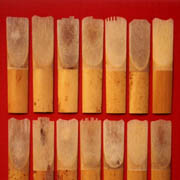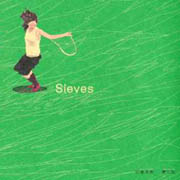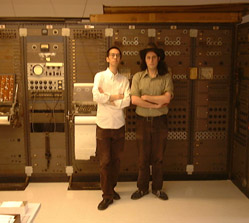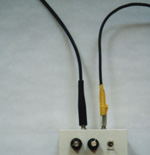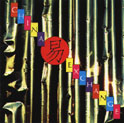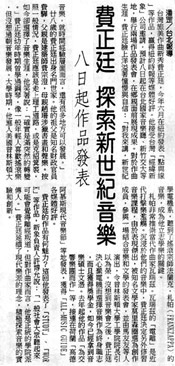I am beginning to think James Fei is really asking for
trouble... The performance that really convinces me that Leo Records
have got a new ace in the pack is for bass saxophone. The big
bass saxophone blows back within an environment that provides the player
with a whole set of obtuse harmonies; it sounds like the place has sheet
metal walls. Solo Works is a declaration, a mark in the sand.
Brilliant things could emerge from this spot; Mr. Fei has chosen to
take the road less traveled. I am prepared to believe James Fei could
be important in the future.
—Steve
Day Avant
...This image (from for bass saxophone) is one
of the most memorable of an impressive group of sounds, ideas, and musical
stories presented by woodwinds player Fei. The splats stick with you
because of their forcefulness, their isolation as individul sound events,
and because of the distinctively rich timbre of the rarely heard bass
saxophone. Although the piece consists of multiphonics, Fei never plays
them the same way twice. Instead, each "sound burst" consists of a number
of pitches heard in varying amounts of clarity and fusion... this complexity
blurs pitch relationships. On the final track Fei attempts to play as
quietly as possible, inviting the listener to adjust to extremely minute
gradations of volume level. The player determines the loudness through
the demands and realities of the sound production, rather than through
a preconceived design. James Fei has wonderful ideas about combining
the unpredictable with the predetermined. His techniques of circular
breathing and multiphonics are well developed, his compositional strategies
challenging, and his musicality evident, not only in the sounds but
also in the sensitive sequencing of the pieces. This is a fine debut
that should be especially welcomed by those who have enjoyed the classic
solo works in the Braxton—Lacy—Evan Parker—Mats Gustafsson continuum.
—Robert
Reigle MusicWorks
Unique and wildly eclectic, this series of nine experimental
solo pieces incorporates, absorbs, and expands the modern aesthetic.
This is one to drive the family crazy... Fei clearly knows what he is
doing, and, however difficult it may be to listen to this recording
at a single setting, it is still—at least at times—an amazingly complex
work of art. Fei's detailed liner notes explaining his concept are a
big plus. [4.5 Stars]
—Steve
Loewy All-Music Guide
|
Fei is an autodidact, it would seem, with an approach
which is rather personal. For example, his use of circular breathing
to produce "isolated sounds in a continuum rather than un-broken melodies"
represents an extremely unusual application of a standard technique.
It's these kinds of right-brain tactics which make this disk so compelling;
the way Fei separates fingering and articulation into discrete, asynchronised
layers in one piece, and then later quotes Stravinsky with a bass clarinet
harmonic. Fei attacks these pieces with gusto, an unfettered enthusiasm
which, impressively, doesn't lead him into cheap "expressivism." There
is an austerity here which works extremely well; these are compositions
stripped down to a single idea, expressed clearly and simply. Highly
recommended. —Richard
Cochrane Musings
Solo sax albums can tend to be pretty tedious affairs, but happily this isn't one of them. I venture to suggest this is because we know in advance that these are compositions, all meticulously titled according to their instrumentation and date of composition. You can even follow a score of Fei's delicate bass clarinet multiphonics, and he sure as hell looks serious in the photo. If he can get such awesome sounds out of the bass saxophone as this, may we look forward to an album of ensemble pieces, or is the playing technique too personal, too idiosyncratic to be reproduced?
—Dan Warburton Paris Transatlantic
Exploring the minute but unmistakable sonic differentiations inherent in the individual instruments themselves... (Solo Works) is undeniably fascinating. Fei's sonic explorations draw in the listener, and turn one's attention to the smallest of variations, as in the best work of John Cage. All those interested in the beautiful possibilities of new music exploration should not pass up James Fei.
—Robert Spencer All About Jazz
Fei's superb playing is rooted in subtle timbral inflections and changes. He demonstrates an awesome control over articulation, dynamics, fingering, multiphonics: the production and shaping of sound. At times, his playing is barely audible ('for bass clarinet (8.97)' and 'for alto saxophone (6.98)', but can rise to screeching multiphonics when called upon ('for bass saxophone (7.98)'. —CDeMUSIC (Electronic Music Foundation)
Saxophonist and electrical engineer, James Fei finds interest in tearing apart and rebuilding motifs, pursuing odd phrasings, half-tones, micro tones and other particulars. Mr Fei is a man who believes in his capabilities while executing his thoroughly fascinating ideas through his analytical aspirations, technical acumen and intriguing philosophies. [****]
—Glenn Astarita All About Jazz
|
